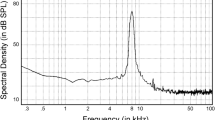Summary
The frog-eating bat,Trachops cirrhosus (Phyllostomatidae), locates frogs by using the frogs' vocalizations and shows a behavioral response to constant frequencies in the sonic range. The minimum intensity needed to elicit a behavioral response to a constant frequency (i.e. threshold intensity) increased as the frequency decreased from 15 kHz to 5 kHz. This is consistent with audiograms of other bats that have been tested in the sonic range. However, the threshold ofT. cirrhosus decreases with frequencies below 5 kHz, which is unusual among bats so far tested in this frequency range. This decreased threshold coincides with the frequencies which characterize frog calls that the bats use to locate their prey.
Similar content being viewed by others
References
Barclay RMR, Fenton MB, Tuttle MD, Ryan MJ (1981) Echolocation calls produced byTrachops cirrhosus (Chiroptera: Phyllostomatidae) while hunting for frogs. Can J Zool 59:750–753
Bell GP (1982) Behavioral and ecological aspects of gleaning by a desert insectivorous batAntrozous pallidus (Chiroptera: Vespertilionidae). Behav Ecol Sociobiol 10:217–223
Brown PE, Grinnell AD, Harrison JB (1978) Development of hearing in the pallid batAntrozous pallidus. J Comp Physiol 126:169–182
Buchler ER, Childs SB (1981) Orientation to distant sounds by foraging big brown bats (Eptesicus fuscus). Anim Behav 29:428–432
Dalland JI (1965) Hearing sensitivity in bats. Science 150:1185–1186
Fiedler J (1979) Prey capture with and without echolocation in the Indian false vampire bat,Megaderma lyra. Behav Ecol Sociobiol 6:155–160
Griffin D (1958) Listening in the dark. Yale University Press, New Haven
Heffner R, Heffner H (1980) Hearing in the elephant (Elephas maximus). Science 208:518–520
Henson OW (1964) Echolocation and hearing in bats with special reference to the function of the middle ear muscles. Ph D thesis, Yale University, New Haven (Connecticut), USA
Henson OW (1970) The ear and audition. In: Wimsatt WA (ed) The biology of bats, vol 2. Academic Press, New York
Loftus-Hills JJ, Johnstone BM (1970) Auditory function, communication, and the brain-evoked response in anuran amphibians. J Acoust Soc Am 47:1131–1138
Long GR, Schnitzler HU (1975) Behavioral audiograms from the bat,Rhinolophus ferrumequinum. J Comp Physiol 100:211–219
Neuweiler G (1968) Neurophysiologische Untersuchungen zum Echoortungssystem der Grossen HufeisennaseRhinolophus ferrumequinum. Z Vergl Physiol 67:273–306
Neuweiler G, Schuller G, Schnitzler HU (1971) On- and off-responses in the inferior colliculus of the greater horseshoe bat to pure tones. Z Vergl Physiol 74:57–63
Pollak G, Henson OW, Novick A (1972) Cochlear microphonic audiograms in the pure tone batChilonycteris parnellii. Science 176:66–68
Rand AS, Ryan MJ (1981) The adaptive significance of a complex vocal repertoire in a neotropical frog. Z Tierpsychol 57:209–214
Ryan MJ, Tuttle MD (in press) The ability of the frog-eating bat to discriminate among novel and potentially poisonous species of frogs using acoustic cues. Anim Behav
Ryan MJ, Tuttle MD, Taft LK (1981) The costs and benefits of frog chorusing behavior. Behav Ecol Sociobiol 8:273–278
Ryan MJ, Tuttle MD, Rand AS (1982) Bat predation and sexual advertisement in a neotropical frog. Am Nat 119:136–139
Sales GD (1975) Auditory evoked responses in small mammals. In: Bench RJ, Pye A, Pye JD (eds) Sound reception in mammals. Academic Press, London
Schuller G (1980) Hearing characteristics and Doppler shift compensation in south Indian CF-FM bats. J Comp Physiol 139:349–356
Simmons JA, Fenton MB, O'Farrell MJ (1979) Echolocation and the pursuit of prey by bats. Science 203:16–21
Suga N, O'Neill WE (1981) Auditory processing of echoes: representation of acoustic information from the environment in the bat cerebral cortex. In: Busnel RG, Fish JF (eds) Animal sonor systems. Plenum Press, New York
Tuttle MD, Ryan MJ (1981) Bat predation and the evolution of frog vocalizations in the neotropics. Science 214:677–678
Tuttle MD, Ryan MJ, Belwood J (submitted) Acoustical partitioning of resources by two phyllostomatid bats
Vernon JA, Peterson E (1966) Hearing in the vampire bat,Desmodus rotundus, as shown by cochlear potentials. J Aud Res 6:153–163
Author information
Authors and Affiliations
Rights and permissions
About this article
Cite this article
Ryan, M.J., Tuttle, M.D. & Barclay, R.M.R. Behavioral responses of the frog-eating bat,Trachops cirrhosus, to sonic frequencies. J. Comp. Physiol. 150, 413–418 (1983). https://doi.org/10.1007/BF00609567
Accepted:
Issue Date:
DOI: https://doi.org/10.1007/BF00609567




